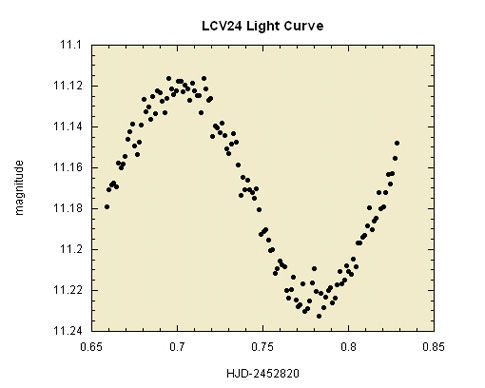
The extensive duration and coverage of the data set allows the astronomers to search for variability in the eclipse timings of these systems as well. A third star in the system will periodically pull the close binary toward and away from earth, causing the eclipse time to vary periodically around the expected time, as the light from the stars has shorter and longer travel distances to earth. This study follows the recent work of Theodor Pribulla of the Astronomical Institute of the Slovak Academy of Sciences, and Slavek Rucinski of the University of Toronto. They studied a large sample of known contact binaries and found that nearly 60 percent of them showed evidence of third stars in the systems. These third components might help model the formation of contact binaries.
The remaining newly discovered variable stars are long period pulsating stars. They have periods of variation ranging from about 50 days to more than 500 days. The stars get brighter and dimmer as they expand and contract, cooling and heating. Most of the stars found have amplitudes of variation smaller than one magnitude. A change of one magnitude represents change of a multiplicative factor of 2.5 in the measured intensity of the starlight. The largest change observed in this study was about 3 magnitudes. By comparison, the sun typically varies in luminosity by less than a tenth of a percent over several years.
Dr. Wes Lockwood at Lowell Observatory and his colleagues have observed a population of solar-like stars and found them, on average, to vary in intensity by about one-tenth of a percent over 2 decades, or about twice as much as the sun in that time. Understanding how many stars in the M23 field vary at low levels will take years of measurements. “We are interested in observing this same field for several more years,” Wilkerson noted. “We’d like to see if the variables we have found have any changes in their amplitudes of periods. We’d like to confirm the variability of several more candidates. One question we have is whether there are any flare events from stars — episodes of sudden brightening. We’re also interested in just how stable the luminosities of all the stars in the field are. If we watch for 10 years, how many will be 10 percent brighter or dimmer? Five percent brighter or dimmer?” The nature of the variability in the recently discovered variable stars will also need to be confirmed with follow-up observations.
In addition to planning repeat observations of the M23 field each year, the Luther astronomy team observes two other open cluster regions each year. The clusters are observed each clear night for five to seven months at a time. Every new field contains more than a thousand stars to be studied. “We keep the data coming in and keep processing it through,” said former team member and current Purdue University graduate student Todd Brown. “With so many stars to look at, there’s bound to be something interesting that pops up. That’s the exciting part; knowing that it’s still possible to study the sky and learn something about these stars that nobody has ever seen before.”
June 13, 2007
Astronomers detected variability in 30 stars in the field of open star cluster M23 in Sagittarius. The observations were presented by Dr. Jeffrey Wilkerson and a team of researchers from Luther College to the American Astronomical Society meeting in Honolulu, Hawaii. These results are part of a long-term study of fields containing bright open star clusters. The study hopes to shed light on how a wide variety of stars vary over many years by monitoring the luminosity stability of normal stars, searching for changes in the periods and amplitudes of variable stars, and waiting for any flares or outbursts.
The research team, consisting of physics professor Wilkerson and six current or former undergraduate students, used a 12-inch diameter telescope on the Luther College campus in Decorah, Iowa, to acquire more than 155,000 images of M23 and the surrounding field over a span of 39 months. During that time, the researchers detected unambiguous variability in 30 stars and possible variability in many more.
Only two of the stars were previously known to be variable. Among the variables are seven eclipsing binaries, in which the light from one star periodically blocks the light from the second star as viewed from earth. Three of these systems are close binaries with orbital periods shorter than 14 hours. In two of these systems, the surfaces of the stars are in contact.
If these contact binaries prove to be members of the star cluster instead of foreground or background stars, Wilkerson said, they will be useful as part of a study of how the systems evolve. Their utility will derive from knowledge of the binary system’s age, since all stars within a single cluster were likely formed nearly simultaneously and the cluster age can be determined. Observation of contact binaries in many clusters of varying ages can help astronomers determine the minimum time it takes for contact systems to form from more widely separated stars. “This is just the beginning,” Wilkerson said. “We hope to find more contact binaries in more clusters.”









